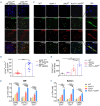ASXL1 mutations accelerate bone marrow fibrosis via EGR1-TNFA axis-mediated neoplastic fibrocyte generation in myeloproliferative neoplasms
- PMID: 36005555
- PMCID: PMC10153516
- DOI: 10.3324/haematol.2021.280320
ASXL1 mutations accelerate bone marrow fibrosis via EGR1-TNFA axis-mediated neoplastic fibrocyte generation in myeloproliferative neoplasms
Abstract
Apart from the central role of the activated JAK/STAT signaling pathway, ASXL1 mutations are the most recurrent additional mutations in myeloproliferative neoplasms and occur much more commonly in myelofibrosis than in essential thrombocythemia and polycythemia vera. However, the mechanism of the association with ASXL1 mutations and bone marrow fibrosis remains unknown. Here, integrating our own data from patients with myeloproliferative neoplasms and a hematopoietic-specific Asxl1 deletion/Jak2V617F mouse model, we show that ASXL1 mutations are associated with advanced myeloproliferative neoplasm phenotypes and onset of myelofibrosis. ASXL1 mutations induce skewed monocyte/macrophage and neoplastic monocyte-derived fibrocyte differentiation, consequently they enhance inflammation and bone marrow fibrosis. Consistently, the loss of ASXL1 and JAK2V617F mutations in hematopoietic stem and progenitor cells leads to enhanced activation of polycomb group target genes, such as EGR1. The upregulation of EGR1, in turn, accounts for increased hematopoietic stem and progenitor cell commitment to the monocyte/macrophage lineage. Moreover, EGR1 induces the activation of TNFA and thereby further drives the differentiation of monocytes to fibrocytes. Accordingly, combined treatment with a TNFR antagonist and ruxolitinib significantly reduces fibrocyte production in vitro. Altogether, these findings demonstrate that ASXL1 mutations accelerate fibrocyte production and inflammation in myeloproliferative neoplasms via the EGR1-TNFA axis, explaining the cellular and molecular basis for bone marrow fibrosis and the proof-ofconcept for anti-fibrosis treatment.
Figures








Comment in
-
"ASXL1"-erating inflammation and bone marrow fibrosis in myeloproliferative neoplasms.Haematologica. 2023 May 1;108(5):1203-1204. doi: 10.3324/haematol.2022.281634. Haematologica. 2023. PMID: 36005565 Free PMC article. No abstract available.
Similar articles
-
Disruption of the ASXL1 gene is frequent in primary, post-essential thrombocytosis and post-polycythemia vera myelofibrosis, but not essential thrombocytosis or polycythemia vera: analysis of molecular genetics and clinical phenotypes.Haematologica. 2011 Oct;96(10):1462-9. doi: 10.3324/haematol.2011.045591. Epub 2011 Jun 28. Haematologica. 2011. PMID: 21712540 Free PMC article.
-
[Research progress on molecular pathogenesis of myeloproliferative neoplasms].Zhongguo Shi Yan Xue Ye Xue Za Zhi. 2011 Feb;19(1):239-43. Zhongguo Shi Yan Xue Ye Xue Za Zhi. 2011. PMID: 21362261 Review. Chinese.
-
[Significance of the JAK2V617F mutation in patients with chronic myeloproliferative neoplasia].Orv Hetil. 2011 Nov 6;152(45):1795-803. doi: 10.1556/OH.2011.29226. Orv Hetil. 2011. PMID: 22011365 Hungarian.
-
The Temporal Sequence and the Differences in Somatic Mutation Acquisition Determines Clinical Behaviors of JAK2-Positive Myeloproliferative Neoplasms.Anticancer Res. 2019 Nov;39(11):6273-6282. doi: 10.21873/anticanres.13837. Anticancer Res. 2019. PMID: 31704857
-
Genetic basis and molecular pathophysiology of classical myeloproliferative neoplasms.Blood. 2017 Feb 9;129(6):667-679. doi: 10.1182/blood-2016-10-695940. Epub 2016 Dec 27. Blood. 2017. PMID: 28028029 Review.
Cited by
-
The Role of Somatic Mutations in Ischemic Stroke: CHIP's Impact on Vascular Health.Neurol Int. 2025 Jan 27;17(2):19. doi: 10.3390/neurolint17020019. Neurol Int. 2025. PMID: 39997650 Free PMC article. Review.
-
Clonal hematopoiesis in LGI1-antibody encephalitis.Ann Clin Transl Neurol. 2024 Oct;11(10):2785-2791. doi: 10.1002/acn3.52192. Epub 2024 Aug 28. Ann Clin Transl Neurol. 2024. PMID: 39199016 Free PMC article.
-
Potential application of the bulk RNA sequencing in routine MPN clinics.BMC Cancer. 2025 Apr 22;25(1):746. doi: 10.1186/s12885-025-13947-x. BMC Cancer. 2025. PMID: 40264064 Free PMC article.
-
Association of Myelofibrosis Phenotypes with Clinical Manifestations, Molecular Profiles, and Treatments.Cancers (Basel). 2023 Jun 24;15(13):3331. doi: 10.3390/cancers15133331. Cancers (Basel). 2023. PMID: 37444441 Free PMC article. Review.
-
"ASXL1"-erating inflammation and bone marrow fibrosis in myeloproliferative neoplasms.Haematologica. 2023 May 1;108(5):1203-1204. doi: 10.3324/haematol.2022.281634. Haematologica. 2023. PMID: 36005565 Free PMC article. No abstract available.
References
-
- Nangalia J, Green AR. Myeloproliferative neoplasms: from origins to outcomes. Blood. 2017;130(23):2475-2483. - PubMed
-
- Tefferi A. Primary myelofibrosis: 2021 update on diagnosis, risk-stratification and management. Am J Hematol. 2021;96(1):145-162. - PubMed
-
- James C, Ugo V, Le Couédic JP, et al. . A unique clonal JAK2 mutation leading to constitutive signalling causes polycythaemia vera. Nature. 2005;434(7037):1144-1148. - PubMed
Publication types
MeSH terms
Substances
LinkOut - more resources
Full Text Sources
Molecular Biology Databases

